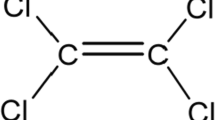Abstract
The purpose of this study was to evaluate the oxidative effect in human lymphocytes after acute nickel (Ni) treatment for 1 h; levels of intracellular reactive oxygen species (ROS), lipid peroxidation (LPO) and hydroxyl radicals (•OH) were examined in isolated lymphocytes. The potential effects of antioxidants were also examined. After acute treatment, NiCl2 (0–10 mM) significantly decreased the viability of lymphocytes. NiCl2 appear to increase the degree of dichlorofluorescein (DCF) fluorescence and the levels of thiobarbituric acid-reactive substances (TBARS) in human lymphocytes in vitro in a concentration-dependent manner. The level of •OH was quantified by two main hydroxylated derivates, 2,3- and 2,5-dihydroxybenzate (DHB). Levels of 2,3- and 2,5-DHB were significantly higher in the Ni-treated group than in controls. Catalase partially reduced the NiCl2-induced elevation of oxidants and TBARS, whereas superoxide dismutase (SOD) enhanced the level of oxidants and TBARS. Both NiCl2-induced fluorescence and LPO were prevented significantly by glutathione (GSH) and mannitol. NiCl2-induced increase in generation of •OH was prevented significantly by catalase, GSH and mannitol, but not by SOD. These results suggest that NiCl2-induced lymphocyte toxicity may be mediated by oxygen radical intermediates, for which the accelerated generation of •OH may plays an important role in Ni-induced oxidative damage of human lymphocytes. Catalase, GSH and mannitol each provides protection against the oxidative stress induced by Ni.







Similar content being viewed by others
References
Andersen HR, Andersen O (1989) Effect of nickel chloride on hepatic lipid peroxidation and glutathione concentration in mice. Biol Trace Elem Res 21:255–261
Chakrabarti SK, Bai C (1999) Role of oxidative stress in nickel chloride-induced cell injury in rat renal cortical slices. Biochem Pharmacol 58:1501–1510
Chen CY, Lin TH (2001) Effect of nickel chloride on human platelets: enhancement of lipid peroxidation, inhibition of aggregation and interaction with ascorbic acid. J Toxicol Environ Health A 62:431–438
Chen CY, Sheu JY, Lin TH (1999) Oxidative effects of nickel on bone marrow and blood of rats. J Toxicol Environ Health A 58:475–483
Chen CY, Su YJ, Wu PF, Shyu MM (2002) Nickel-induced plasma lipid peroxidation and effect of antioxidants in human blood: involvement hydroxyl radical formation and depletion of α-tocopherol. J Toxicol Environ Health A 65:843–852
Coogan TP, Latta DM, Snow ET, Costa M (1989) Toxicity and carcinogenicity of nickel compounds. CRC Crit Rev Toxicol 19:341–384
Cotton FA, Wilkinson G (1980) Advanced inorganic chemistry, a comprehensive text, 4th edn. Wiley, New York
Fraga CG, Leibovitz BE, Tappel A (1988) Lipid peroxidation measured as thiobarbituric acid reactives in tissue slices: characterization and comparison with homogenates and microsomes. Free Radical Biol Med 4:155–161
Frenkel K, Gleichauf C (1991) Hydrogen peroxide formation by cells treated with a tumor promoter. Free Radic Res Commun 12–13:783–794
Grinberg LN, Rachmilewitz EA, Kitrossky N, Chevion M (1995) Hydroxyl radical generation in β-thalassemic red blood cells. Free Radic Biol Med 18:611–615
Gutteridge JMC, Halliwell B (1990) The measurement and mechanism of lipid peroxidation in biological system. Trends Biochem Sci 15:129–135
Huang X, Frenkel K, Klein CB, Costa M (1993) Nickel increased oxidants in intact cultured mammalian cells as detected by dichlorofluorescein fluorescence. Toxicol Appl Pharmacol 120:29–36
Inoue S, Kawanishi S (1989) ESR evidence of superoxide, hydroxyl radicals and singlet oxygen produced from hydrogen peroxide and nickel(II) complex of glycylglycyl-l-histidine. Biochem Biophys Res Commun 159:445–451
Kasprzak KS (1991) The role of oxidative damage in metal carcinogenicity. Chem. Res. Toxicol. 4:604–615
Klein CB, Frenkel K, Costa M (1991) The role of oxidative processes in metal carcinogenesis. Chem Res Toxicol 4:592–604
LeBel CP, Ischiropoulos H, Bondy SC (1992) Evaluation of the probe 2',7'-dichlororfluorescin as an indicator of reactive oxygen species formation and oxidative stress. Chem Res Toxicol 5:227–231
Misra M, North SL, Rodriguez RZ, Kasprzak KS (1991) Nickel-induced renal lipid peroxidation in different strains of mice: concurrence with nickel effect on antioxidant defense system. Toxicol Lett 58:121–133
Ohyashiki T, Kobayashi M, Matsui K (1991) Oxygen-radical-mediated lipid peroxidation and inhibition of ADP-induced platelet aggregation. Arch Biochem Biophys 288:282–286
Salnikow E, Gao M, Voitkun V, Huang X, Costa M (1994) Altered oxidative stress responses in nickel-resistant mammalian cells. Cancer Res 54:6407–6412
Shi X, Castranova V, Halliwell B, Vallyathan V (1998) Reactive oxygen species and silica-induced carcinogenesis. J Toxicol Environ Health B 1:181–197
Stinson TJ, Jaw S, Jeffery EH, Plewa M (1992) The relationship between nickel chloride-induced peroxidation and DNA strand breakage in rat liver. Toxicol Appl Pharmacol 117:98–103
Stohs H, Bagchi D (1995) Oxidative mechanisms in the toxicity of metal ions. Free Radic Biol Med 8:321–336
Sunderman FW Jr (1989) Mechanism of nickel carcinogenesis. Scand J Work Environ Health 15:1–12
Sunderman FW Jr, Dingle B, Hopfer SM, Swift T (1988) Acute nickel toxicity in electroplating workers who accidentally ingested a solution of nickel sulfate and nickel chloride. Am J Ind Med 14:257–266
Tkeshelashvili LK, Reid TM, McBride TJ, Loeb LA (1993) Nickel induces a signature mutation for oxygen free radical damage. Cancer Res 53:4172–4174
Torreilles J, Guerin MC (1990) Nickel(II) as a temporary catalyst for hydroxyl radical generation. FEBS Lett 272:58–60
Acknowledgements
This study was supported by Fooyin University, Taiwan (FY 90-007).
Author information
Authors and Affiliations
Corresponding author
Rights and permissions
About this article
Cite this article
Chen, CY., Wang, YF., Lin, YH. et al. Nickel-induced oxidative stress and effect of antioxidants in human lymphocytes. Arch Toxicol 77, 123–130 (2003). https://doi.org/10.1007/s00204-002-0427-6
Received:
Accepted:
Published:
Issue Date:
DOI: https://doi.org/10.1007/s00204-002-0427-6




